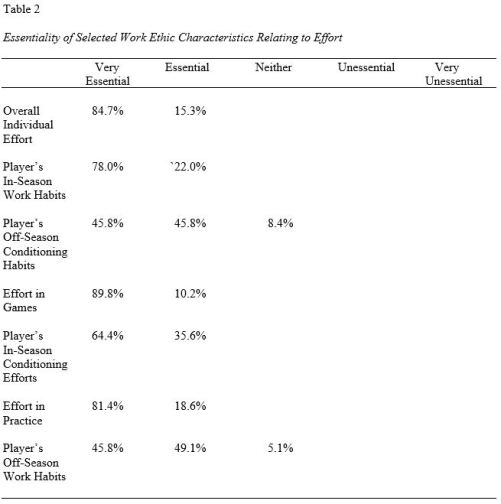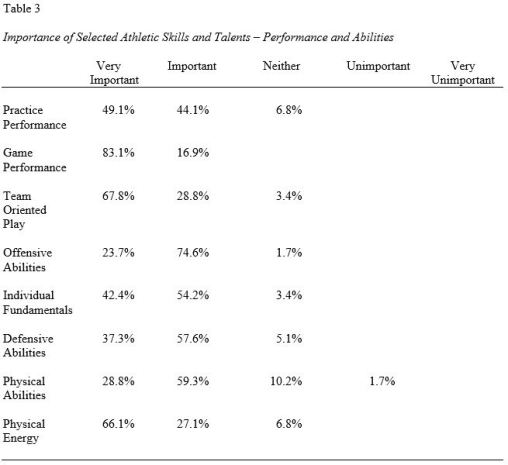Abstract
A national survey of selected men’s basketball coaches, at the NCAA Division I level, revealed how essential the respondents felt certain work ethic characteristics were for successful basketball players on their team. The respondents also revealed how important specific skills or talents were for the success of men’s NCAA men’s Division I basketball programs. The survey was completed by means of a 36-item Likert scale questionnaire. This investigation determined to what degree NCAA Division I coaches should seek specific work ethic characteristics and physical skills/talents in their players.
Introduction
College basketball coaches seek athletes with high caliber skills and specific basketball talent as well as a good overall work ethic. Although there is plenty of antidotal information regarding the type of desirable skills and talent desirable in the world of basketball, there has been very little definitive research done in terms of determining exactly what skills, talent and examples of work ethic are highly rated by coaches of men’s basketball at the NCAA Division I level of competition (Stier, 1997).
Successful and effective coaching is a highly complex and multi-dimensional enterprise (Jones, Housner, and Kornspan, 1997). It is very important, according to Owens & Stewart (2003) to be able to understand individual squad members’ physical, emotional, social and cognitive needs if the team is to be successful, that is, win. In a study by Forman (1995), it was determined that college basketball coaches need to make a commitment to each player’s growth and improvement in the sport if the team, as a collective unit, is to emerge victorious in actual competition,
In a study of elite athletes by Mallet & Hanrahan (2004), it was determined that players recognize the need to train hard to be winners. Training hard implies working diligently to improve both individual and team performance in order to produce meaningful results when it counts, in actual competition (Laios and Theodorakis, 2002). This emphasis on both individual and team (collective) training is reinforced by Bursari, (2000).
Elite athletes exhibit significant effort in games as well as in practice and this dedication extends to off-season work habits (Adams, 1996). The ability and willingness to work hard as well as to work harder are important examples of an athlete’s ability that can lead to success on the proverbial playing field, especially if the coach believes in the athlete and is successful in motivating the individual player to work harder (Jowett, 2003).
Literature presented by Stier (1998) included several major factors that distinguish consistent winning teams from teams that consistently lose: (a) better skilled athletes and (b) better conditioned athletes. The importance of adequate strength and conditioning was emphasized by Laios and Theodorakis (2002). Dirks (2000) studied control variables of team performance representing elements of the coach and players’ talent. And, in 1999, Pascarella et al. looked at the topic of physical energy that is required of athletes in actual competition.
Purpose of the Study
The purposes of this study were two-fold. The first purpose was to determine the essentiality of selected work ethic characteristics on behalf of athletes. And, the second was to determine the importance of specific skills or talents of athletes to the success of men’s NCAA men’s Division I basketball programs. In summary, this investigation sought to determine to what degree coaches should seek in their Division I men’s basketball players’ specific work ethic characteristics and physical skills/talents.
Methods
The Questionnaire
A survey instrument was developed from the existing current literature related to work ethic characteristics of players as well as specific athletic skills and talents that might have an effect on the success or failure of NCAA Division I men’s basketball programs. An extensive literature search found basketball related articles in which work ethic characteristics and various athletic skills and talent for athletes engaged in basketball were identified and which served as the foundation for the 36 items included on the Likert scale statements of the questionnaire.
Of the total of 36 Likert scale statements, 15 related to work ethic characteristics while 21 related to athletic skills and talents that might have an impact upon the success or failure of Division I men’s basketball programs. For work ethic characteristics, respondents were instructed to circle the number that corresponded with the degree of essentiality they believed most accurately depicted the impact that selected work ethic characteristics have upon the success [winning games] of their basketball programs and had the following categories of essentiality from which to choose: 5 – Very Essential, 4 – Essential, 3 – Neither Essential nor Unessential, 2 – Unessential, and 1 – Very Unessential. For the second category, specific athletic skills and talents, the coaches had the following Likert scale options which included the following choices of importance from which they were asked to circle the corresponding number: 1 – Very Important, 2 – Important, 3 – Neither Important nor Unimportant, 4 – Unimportant, and 5 – Very Unimportant.
To help address content validity a draft of the survey questionnaire was completed by five Division I head basketball coaches who were determined to be expert coaches for the purpose of gaining feedback regarding the instrument. In order to be deemed an expert coach, the coaches were required to have coached men’s basketball at the Division I level for at least 10 years and won at least 75% of their games during that time. After receiving the feedback from the expert coaches, appropriate suggestions and recommendations were incorporated into the final version of the survey instrument which was then utilized in this national study. The University’s Internal Review Board reviewed the final, revised version of the instrument and gave its approval.
The subjects for this national survey included all 315 men’s NCAA Division I head basketball coaches whose names and addresses were provided by the NCAA national headquarters. Of these, 118 completed and returned usable surveys generating a return rate of 37.5%.
Results
Work Ethic – Training
The category of work ethic contained two general categories, (a) training and (b) effort.
Of the eight characteristics related to training, six pertained directly to players’ training; two pertained to sacrifices made by athletes and the remaining two dealt directly with the athletes’ state of physical conditioning. Training hard was deemed to be the single most essential characteristic for winning, according to the respondents. In fact, 74.6% of the coaches indicated that training hard was very essential to winning while 25.4% classified it as essential.
Strength and conditioning was likewise thought to be very essential by a large percentage of coaches (72.9%), and deemed essential by 25.4%. Individual training was the only other work ethic characteristic thought to be very essential by more than half of the coaches (52.5%), while another sizeable group of coaches (44.1%) also classified this characteristic as essential. Table 1 shows all eight work ethic characteristics and how the respondents classified each in terms of how essential they are to winning basketball games at the Division I level.
Work Ethic – Effort
Of the seven characteristics identified in the survey as being related to effort, three dealt directly with effort, two addressed the conditioning efforts of players, while the remaining two involved how essential were the players’ work habits—in the eyes of the responding coaches. Individual player’s effort, in general, was consistently valued very highly by coaches with five of the seven categories deemed to be very essential by more than sixty percent (64.4%) of the respondents. Only two categories relating to effort were deemed to be very essential by less than half of the coaches, and both related to off-season activities. These were (a) player’s off-season conditioning efforts (45.8%) and (b) player’s off-season work habits. Table 2 illustrates how essential the coaches viewed these seven work ethic characteristics that related to effort.
Athletic Skills and Talents – Performance and Abilities
The section on athletic skills and talents contained two general categories, (a) performance/skills and (b) basketball talent. Of the eight performance skills identified in the investigation, two related directly with performance, two pertained directly to individual and team play while three dealt with abilities of players. The remaining skill is related to the physical energy that a player exudes. Only three performance skills were deemed to be very important by more than half of the coaches responding to the survey: (a) game performance (83.1%), (b) team oriented play (67.8%), and (c) physical energy (66.1%). Table 3 illustrates how the respondents rated each of the eight performance/abilities in terms of their importance or unimportance to winning Division I basketball games.
Athletic Skills and Talents – Basketball Talent
Of the 21 basketball talent categories that the coaches rated in terms of importance, 7 items related to physical talent while the remaining 14 focused on specific basketball skills. Defense, with 57.6% of the coaches, and passing, with 55.5%, were the only talent items that more than half of the respondents rated as very important. Two other talent categories are worth noting in that both (a) overall fundamental base and (b) rebounding were the only two talent categories that all the respondents classified as very important or important. Table 4 shows how the coaches classified all of the categories of basketball talent relative to their importance of unimportance in terms of their impact upon winning.
Conclusions
This national investigation sheds light on how Division I basketball coaches view the essentiality of specific work ethic characteristics and the importance these coaches place on specific skills or talents identified as having impact upon winning in competition. The results have implications for coaches in respect to what qualities, characteristics, skills and talents to look for in terms of potential recruits as well as current team members.
References
- Adams, M.J. (1996). The perception of high school players and coaches in regard to individual and team efficacy in basketball. Unpublished doctoral dissertation, University of North Carolina at Greensboro.
- Bursari, J.O. (2000). Revisiting analogy as an educational tool – PBL and the game of basketball. Medical Education, 34, 1029-1031.
- Dirks, K.T. (2000). Trust in leadership and team performance: evidence from NCAA Basketball. Journal of Applied Psychology, 85, 1004-1012.
- Forman, B. (1995). Factors of hiring head coaches in collegiate athletics. Unpublished master’s thesis, Ball State University, Muncie, Indiana.
- Jones, D.F., Hosnder, L.D., & Kornspan, A.S. Interactive decision making and behavior of experienced and inexperienced basketball coaches during practice. Journal of
- Teaching in Physical Education, 16, 454-468.
- Jowett, S. (2003). When the “honeymoon” is over: a case study of a coach-athlete dyad in
- crisis. The Sport Psychologist, 17, 444-460.
- Laios, A., & Theodorakis, N. (2002). The pre-season training of professional basketball teams in Greece. International Sports Journal, 6(1), 146-152.
- Mallet, C.J., & Hanrahan, S.J. (2004). Elite athletes: why does the ‘fire’ burn so brightly?
- Psychology of Sport and Exercise, 5, 183-200.
- Owens, L. & Stewart, C. (2003). Understanding athletes’ learning styles. International Society of Biomechancis in Sport, Coach Information Service, http://www.education.ed.ac.uk/cis/index.html.
- Pascarella, E.T., Truckenmiller, R., Nora A., Terenzini, P.T., Edision, M., & Hagedorn, L.C. (1999). Cognitive impacts of intercollegiate athletic participation. The Journal of Higher Education, 70, 1-26.
- Stier, W. F., Jr. (1997). Coaching modern basketball — Hints, strategies and tactics. Boston, MA: Allyn & Bacon.
- Stier, W. F., Jr. (1998). Coaching concepts and strategies (2nd ed.). Boston: American Press.





